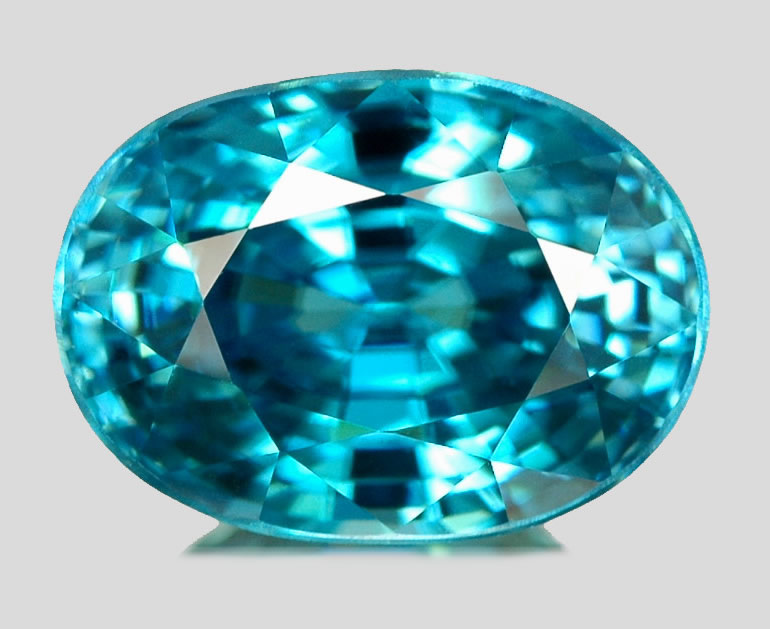Zircon is the birthstone for September. No one knows for sure where the zircon got its name, but possibly it could come form the Arabic "zarkun" which means red colored, or from the Arabic word "zargun" which means gold colored. Many people get zircon confused with cubic zirconia but they are completely different stones. Zircon is a mined stone, whereas cubic zirconia is a man-made zircon. Zircon has a high refractive index. Most of the time, zircon is heat-treated, which produces many colors. Zircons are most often seen with a blue color and while there are real blue zircons, there are not enough for the commercial market and that is why they are heat-treated.
 |
Heat
Treated |
Zircon can be used as a talisman to guard travelers from either wild animals or a snake's bite. It can also stop bleeding if one wears it as an amulet. Zircon helps women to give birth easily. It can improve memory and mental abilities. Zircon in the Middle Ages was also thought to drive away plaques and evil spirits. They were thought to bring wisdom and honor.
Zircon is considered a gemstone of exquisite beauty. Its high refractive index makes it sparkle. It was used as the "poor man's" diamond in the 18th and 19th century. Zircon comes in all colors and their sparkle make them highly desirable. Most Zircon comes from India, Sri. Lanka, and Vietnam.
Anyone owning a true zircon is lucky indeed.

 Another famous diamond is the Shah Diamond. It is one of the most famous stones in history. It was found in 1450 in Central India. It was created for the Nizam Shahi court in Ahmednagar, which is the largest district in the state of Maharashtra. It is a light, yellowish brown color and incredibly clear. It is a large stone at 88.7 carats. Nizam had the first inscription put on one of the facets of the stone in 1591. Nizam's grandson Shah Jehan, who loved stones, added a second inscription in 1641. Jehan's son who was named Aureng- Zeb was the next person to inherit the diamond. He put the diamond above his throne. Until 1738 the Diamond Shah was held in Delhi. When India was attacked in 1738 the stone was taken back to Persia (Iran). In 1829 a Russian diplomat was killed in Tehran, Persia and the Russians demanded punishment. The Shah's grandson, Khosrow Mirza went to St. Petersburg to give the Shah Diamond as a peace offering. Therefore, the Shah Diamond now rests in the Kremlin in Russia.
Another famous diamond is the Shah Diamond. It is one of the most famous stones in history. It was found in 1450 in Central India. It was created for the Nizam Shahi court in Ahmednagar, which is the largest district in the state of Maharashtra. It is a light, yellowish brown color and incredibly clear. It is a large stone at 88.7 carats. Nizam had the first inscription put on one of the facets of the stone in 1591. Nizam's grandson Shah Jehan, who loved stones, added a second inscription in 1641. Jehan's son who was named Aureng- Zeb was the next person to inherit the diamond. He put the diamond above his throne. Until 1738 the Diamond Shah was held in Delhi. When India was attacked in 1738 the stone was taken back to Persia (Iran). In 1829 a Russian diplomat was killed in Tehran, Persia and the Russians demanded punishment. The Shah's grandson, Khosrow Mirza went to St. Petersburg to give the Shah Diamond as a peace offering. Therefore, the Shah Diamond now rests in the Kremlin in Russia.
 |
| Imperial Topaz |
Topaz is the birthstone for November. According to Pliny, the Greek scholar, he named topaz after the Island of Topazos in the Red Sea. However, it is likely that the name came from the Sanskrit word "tapas" which means fire. Topaz can be found in all kinds of colors, such as blue, pink, colorless, brown, green, but yellow being the most common. Imperial topaz is yellow, pink, or a pink-orange. Topaz are found in Sri Lanka, Brazil, Pakistan, Russia, and many other countries that have fluorite and cassiterite.

 Topaz was colored with the golden glow of the sun god Rah, according to the Egyptians. They also believed, if worn as an amulet, it would protect from injury. The Romans related topaz with Jupiter, their version of a sun god. The Romans also thought it had the power to improve eyesight. The Greeks thought it would increase strength and also aid in emergencies by making its wearer invisible. It was considered to heal physical and mental disorders and even prevent death during the Middle Ages.
Topaz was colored with the golden glow of the sun god Rah, according to the Egyptians. They also believed, if worn as an amulet, it would protect from injury. The Romans related topaz with Jupiter, their version of a sun god. The Romans also thought it had the power to improve eyesight. The Greeks thought it would increase strength and also aid in emergencies by making its wearer invisible. It was considered to heal physical and mental disorders and even prevent death during the Middle Ages.







